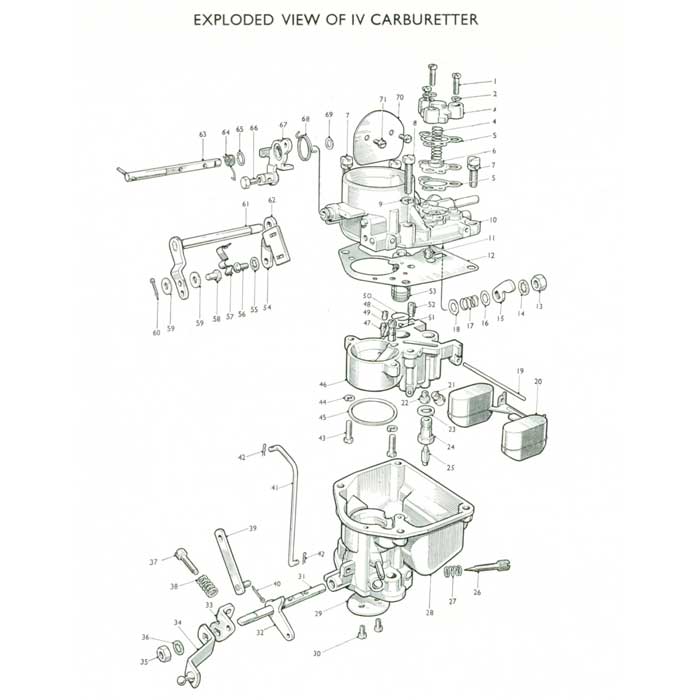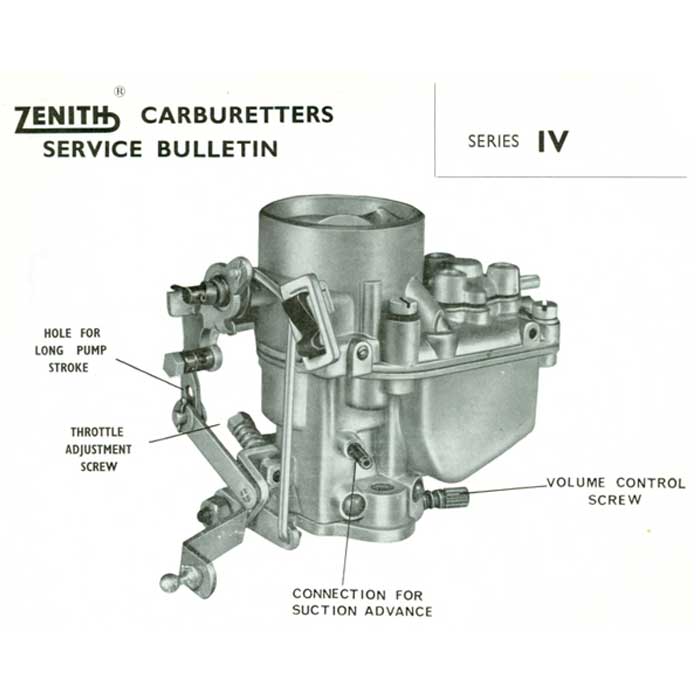
The IV series carburetters are of downdraught design and a further development of the successful "V" type instruments we have manufactured over a number of years. Improvements embodied are twin floats in a float chamber set close to the throttle bore to give a high flooding angle, effectively controlling fuel level so that performance is not affected by angles of incline, fast acceleration, harsh braking, or surging on bends. The emulsion block, or jet carrier, has an outlet in the centre of a lead-in to the choke restriction that is cast in the barrel portion of the instrument.
All jets and the accelerator pump piston are in the emulsion block which can be readily removed with a screw driver and a 1 inch Spanner. The float chamber has no screws or plugs on the exterior and is cast in one piece with the throttle barrel, thus eliminating any joint below the fuel level from which petrol can leak outside the carburetter.
The design and construction ensure a very free-breathing instrument that will pass maximum volume or weight of mixture relative to the bore diameter.
Operation
The petrol inlet 21 at the top of the float chamber is a parallel tube to accommodate plastic fuel pipe. From here, fuel enters the float chamber via the needle seating 20, where the flow is controlled by the needle 19, and the float 18. As the petrol level rises, the float lifts. And by means of the arm connecting the twin floats Closes the needle on its seating, when the correct level has been attained. When the engine is running. Petrol is drawn from the float chamber; the float descends and more fuel is then admitted through the needle seating. By this means, the correct level is automatically maintained the whole of the time the carburetter is in action.
Petrol in the float chamber surrounds the emulsion block which houses the main jet 17, compensating jet 27. Slow-running jet 22 and pump jet 15. Together with the inlet non-return valve 11 to the pump cylinder and fuel will pass through jets and channels to the same level as exists in the float chamber.
Starting from cold
When the choke control is pulled out it operates a lever 7 at the side of the air intake. This allows the spring-loaded strangler, or choke spindle, to which the strangler flap 8 is affixed. To rotate and close the air intake; simultaneously. The interconnection rod 1. between the strangler lever and a loose lever 3 on the throttle spindle opens the throttle, beyond the normal idle position to provide fast-idle.
On switching on the ignition and rotating the engine it will fire and run. The increased depression in the carburetter when the engine starts. will open the strangler flap against the spring action that held the flap closed preparatory to starting. Thus the mixture is weakened to avoid over-choking once the engine is running. As the engine warms up the choke control should be pushed in to open the strangler flap and reduce the fast-idle speed.
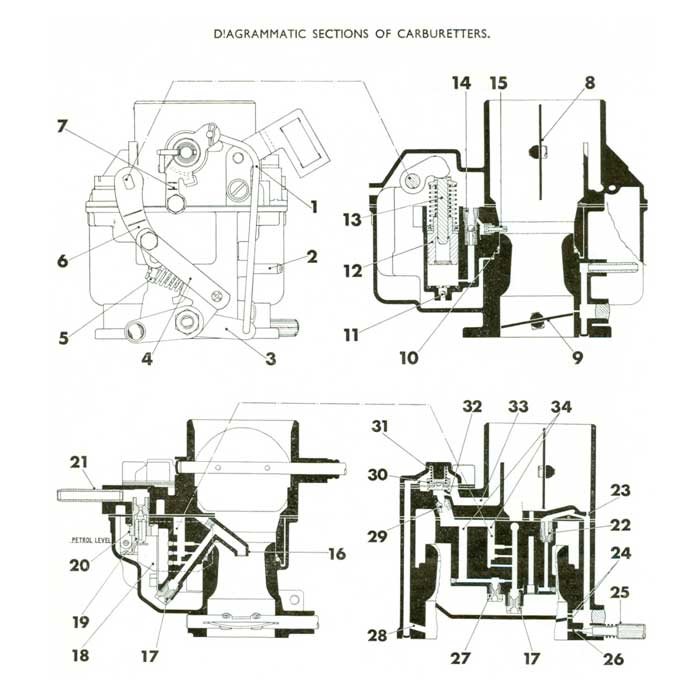
The main circuit
As the instrument has embodied a mechanically operated accelerating pump. One can usually start without using the strangler or choke. by depressing the accelerator pedal once or twice before. Or during. The period the starter is rotating the engine. Do not use the choke and pump the accelerator. as this could cause delay in starting by over-choking.
When the throttle 9 is in the idling position the mixture is supplied by the slow-running jet 22. Which obtains its fuel from the metered side of the main jet 17 (at the base of the emulsion block). through a calibrated restriction. The petrol from the jet is emulsified by air bleeding to the vertical channel. through the orifice 23. This opens into the air intake. The resulting mixture is then drawn down the channel to the idle hole 26 in which the tapered end of the volume control screw 25 enters. Alternative sizes of slow-running jets are available although it is not usual to have to make any variation from the standard size as specified for a particular application.
In certain applications of the "IV" carburetter the slow-running jet 22 has incorporated a ball valve. The purpose of this valve is to eliminate what is termed 'back bleeding' of air into the main carburetter jet circuit. Adjustments to the idling are made by both the throttle stop screw 5 and the volume control screw 25. Turning the throttle stop screw clockwise increases the speed of idling and turning the volume control screw clockwise weakens the idling mixture.
The two small holes 24, at the edge of the throttle, communicate with the idle channel. Their function is to provide additional mixture as the throttle is opened from the idle position and before fuel commences to emerge from the outlet of the main carburetter. They are known as progression holes and the size and positioning, relative to the throttle edge are critical to ensure smooth progressive acceleration. They are not adjustable and should not be tampered with.
The main circuit
As the throttle continues to open, increased depression in the waist of the choke tube restriction, on which is located the outlet from the emulsion block, will cause fuel to issue from the outlet that is fed by the main and compensating jets 17 and 27 respectively. As the fuel level in the channels above the jets falls, air will enter the top of the capacity wells 34, to the compensating jet and to the channel above the main jet. The amount of air bleeding is controlled by the full throttle air bleed hole 32 (which remains permanently open) and also at times by the larger orifice in the ventilation screw 29, this being controlled by the economy diaphragm valve 30.
Consequently fuel from the outlet of the emulsion block will be a mixture of air and petrol which, when it arrives at the outlet 16, is further atomised as it meets the current of air passing through the choke tube, or venturi restriction, in the bore of the carburetter. The main and compensating jets are made in a range of sizes, as are the ventilation screws and these sizes decided upon for a particular application are determined best to meet engine requirements throughout the part and full throttle range of the engine.
Economy device
On the float chamber cover adjacent to the air intake is a small casting attached by three screws. Under the cover is a diaphragm valve 30 which is normally held in a flexed condition by a compression spring. The chamber above the diaphragm is in communication via a hole in the cover and a channel in the body to an outlet 28, in the throttle bore on the engine side of the throttle.
Under part throttle cruising conditions the manifold depression is high. This depression (or "suction") is imposed on the spring-loaded side of the diaphragm, thereby lifting the valve from its seat, to admit further air from the passage 33, in communication with the air intake, to increase ventilation to the jets and weaken the mixture in order to ensure the best possible consumption figures. With the valve off its seating, under conditions of high manifold depression, the extent of the ventilation for cruising is controlled by the ventilation screw 2
When depression in the manifold is low, as at wide throttle openings, and maximum power is required, the diaphragm valve remains on its seating and the extent of ventilation to the jets is restricted to the small "Full Throttle Air Bleed" 32, into the channel below the valve. The action of the economy device is entirely automatic and is controlled by the demands of the engine.
Accelerating pump
The purpose of this feature is to prevent any hesitation in accelerating, that might otherwise occur, when a carburetter is adjusted to provide the leanest mixture at part-throttle cruising. To obtain economical running at such speeds, a controlled and metered supply of fuel is required when the throttle is opened quickly, and this is supplied by the accelerating pump.
When the pump piston 12 is at the top of its stroke, the cylinder is charged with fuel admitted from the float chamber through the non-return inlet valve 11. Upon the throttle being opened, the piston rod 13 is forced down, both inner and outer springs being compressed and expansion of the inner spring, bearing on the top surface of the piston, forces this down to discharge a stream of petrol through the non-return valve 14 and the pump jet 1. Continuing expansion of the spring, to the extent of the movement of the rod 13 through the piston, ensures a follow-up of the pump operation after the throttle movement, accelerating the engine. has ceased.
The outer spring ensures the return of the pump piston and rod to the top of its stroke and recharges the cylinder with fuel. The travel of the piston may be varied as required, giving a short stroke for summer and a long stroke for winter. The change in length of stroke is effected in the linkage 4 from throttle to the pump operating lever 6. When the pivot or pin is in the hole at the end of the pump tiltting lever 6 the stroke is short, and the inner hole provides maximum stroke of the piston (the position shown).
Automatic ignition-advance control
A connection 2 is provided in the throttle body for suction operated automatic ignition-advance control. The small hole, where it breaks through into the throttle bore, is very carefully drilled both for size and position, and should on no account be tamper-ad with.
General
To gain access to the emulsion block and float mechanism, remove the four screws in the top half of the carburetter and take out the clevis pin on the pump linkage after removing the split pin, when the top half can be lifted off. See fig. 3. The main and compensating jets in the base of the emulsion block have screw-driver slots and can be taken out for cleaning without further dismantling. The jet at an angle is the main jet and the compensating jet is vertical.
It should be noted that these two jets are cadmium plated, in order to distinguish them from other jets of similar size and shape but which have a plain brass finish. Although the two types appear to be identical, their flow characteristics are entirely different, hence it is important that plated main and compensating jets only are used in this series of carburetters. No washers are needed on these jets.
To remove the emulsion block after taking off the top half, first slide out the float hinge pin in either direction and lift away the float. The fuel inlet needle can then be lifted from its seating. Two screws with spring washers and the needle seating are next removed when the emulsion block can be lifted clear. See fig. 4. Take care not to lose the soft aluminium washer that ensures a petrol tight joint for the seating on the under surface of the emulsion block.
On lifting off the block the pump assembly will drop out. The cover gasket between the block and the top half can then be lifted away and replaced if necessary. The pump piston rod and spring assembly is not designed to be taken apart. The slow-running jet and the pump discharge valve screw in the top face of the emulsion block and the pump discharge jet screws in the side of the block.
At the base of the pump cylinder is the ball inlet valve, the ball is retained by a circlip, and it should not be necessary to remove this as the valve can easily be cleaned with an air line or syringed with clean petrol to remove any sediment.It will be noted that the choke tube restriction in the IV series is incorporated in the throttle barrel, or lower half of the carburetter.
Surrounding the spigotted top end of the choke restriction there is fitted a circular rubber "0" ring 10, to provide an effective seal with the emulsion block, when the top half with the block is refitted in position. In dismantling the carburetter examine the "0" ring to ensure it is sound and if in any doubt replace (a new "0" ring is included in the Gasket Pack we offer for this series).
The brass jet, with screwdriver slot, screwing in the underside of the top half, as seen when the emulsion block is removed, is the ventilation screw 29. With the emulsion block removed from the top half there are exposed a number of drillings in the cover and it is essential all are clear, pay particular attention to those which break through into the air intake of the instrument.
In re-assembling the top half, see the gasket lines up with the drilled holes in the underside of the cover. and the short cam lever on the pump spindle is in the recess to line up with the pump assembly in the emulsion block. Place the block in position on the cover and screw in the needle seating, then fit the screws with their washers and tighten all these evenly and fully. Next drop the needle in its seating and fit the float by sliding in position the axle pin. There is no fixing for the pin as end movement is limited by the interior of the float chamber, when the top half is in position. While the top half is off, dismantle the economy device by removing the three screws and lifting off the small die-cast cover. A gasket is used on each side of the diaphragm.
ADJUSTMENTS
A number of variables are incorporated in the IV series of carburetters which enable the instrument to be tuned to provide correct fuel/air ratio at all points in the range of throttle movement, and for all speeds and loads. In those instances where the IV carburetter is fitted as initial equipment on a standard make and model of engine, it will be appreciated that the sizes ofthe jets and other variables in the instrument have been decided only after most lengthy tests both on the bench and on the road, by our engineers working in collaboration with the Experimental and Road Test Department at the vehicle
manufacturers. In such cases, we recommend that no changes should be made to these standard settings without first making a careful
investigation of other engine factors, such as ignition, valve tappet adjustment, etc.
Unless otherwise stated, all the jets and air bleeds used in this carburetter are calibrated in units of hundredths of a millimetre. Main, compensating, slow-running and pump jets are normally available in steps of five units, and air bleeds in ten. In all cases, a higher number indicates a larger calibration, and therefore a jet stamped 105 is the next size smaller than one marked 110.
Half-size main and compensating jets can be supplied to order for final tuning, one stamped 97 being midway between 95 and 100.
Altitude
The obvious exception to the above comment on altering the standard setting will arise in those cases where a vehicle is being operated at heights in excess of 5,000 feet. Where it is consistently used on roads at these altitudes some reduction in sizes is necessary, to maintain the correct fuel/air ratio at the rarefied atmosphere.
Below we detail recommended changes to main and compensating jets for different altitudes.
5,000 to 7,000 ft, 7,000 to 10,000 ft, 10,000 to 15,000 ft.
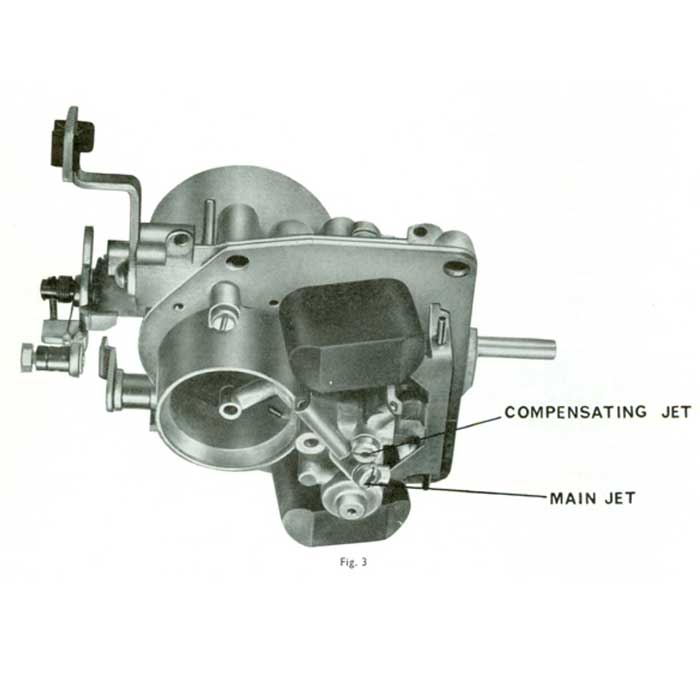
While no change is specified for altitudes up to 5,000 feet, in cases where an owner is more concerned with economy thanPerformance it would be worthwhile trying the smaller main jet, when the altitude exceeds 3,500 feet.
It must be made clear that the foregoing suggested changes will apply only in those instances where the vehicle operates consistently at altitude; no change need be made in a run where the car climbs to a few thousand feet, then drops down again to below 2,000 feet or thereabouts as, for instance, in a journey over the European Alps. In addition to the changes to the main and compensating jets referred to in the paragraph on altitude, there are other items in the setting of the carburetter that can be altered when adjusting the instrument to suit a particular engine. These are as follows: Choke tube. In the IV series of carburetters this is cast in the throttle body and cannot be varied.
The size embodied in a carburetter fitted as initial equipment is that which will pass weight of mixture to ensure full power from the standard engine. Main jet. As in most models of the Zenith carburetter the mixture at speeds above idling is provided by two jets, the main jet and compensating jet. In the IV series both of these feed simultaneously into the main channel of the emulsion block, the outlet from which protrudes into the choke tube at its smallest diameter.
The main jet will influence power and speed; when the drilling or passage above this jet is exhausted of fuel, the output will be related to the depression existing in the choke tube and then, in turn, to that in the main passage of the emulsion block.
Compensating jet. As already mentioned in reference to the main jet, the output of the compensating jet is complementary to that of the main jet, both feeding into the main channel of the emulsion block. The head of the channel in which the compensating jet screws is ventilated to the atmosphere by means of the main air bleed, while the petrol and air flow from the compensating jet is through the restriction near the base of the drilling in which the compensating jet screws. Thus, when petrol above the compensating jet is exhausted on acceleration, an emulsion of petrol and air will be drawn through this restriction into the main passage of the emulsion block.
As in the case of the main jet, the compensating jet will feed petrol at all times (other than idling) to the main outlet of the emulsion block, and consequently any variation to the size of this jet will have an influence on mixture strength throughout the throttle range. It is therefore the combined output of the main and compensating jets that will provide the mixture strength to give the best performance of which the motor is capable.
Variations to the size of the compensating jet will not have so great an influence on mixture strength as will an alteration to the main jet.
Slow-running jet
Its name indicates the purpose of this jet, which has a calibrated hole and meters the petrol to both the slow-running hole on the engine side of the throttle, and to the two small "progression" holes at the throttle edge. Half-size slow-running jets are unnecessary, as the volume control screw in the throttle barrel enables the strength of the mixture to be regulated to suit a particular engine. It is only in exceptional cases that it may be necessary to alter the size of the jet from that fitted by the car manufacturers.
Slow-running air bleed
The drilled hole 23 from the slow-running passage into the air intake, bleeds air to the circuit and serves also as an anti-syphon hole
Ventilation screw
At part throttle operation when manifold depression is high the diaphragm 30 will be off its seating to open the orifice under the metal insert of the diaphragm and admit air from the channel 33. The ventilation screw 29 will then control the degree of air bleeding to the compensating jet, also to the cross channels drilled into the main passage of the emulsion block, just above the main jet.
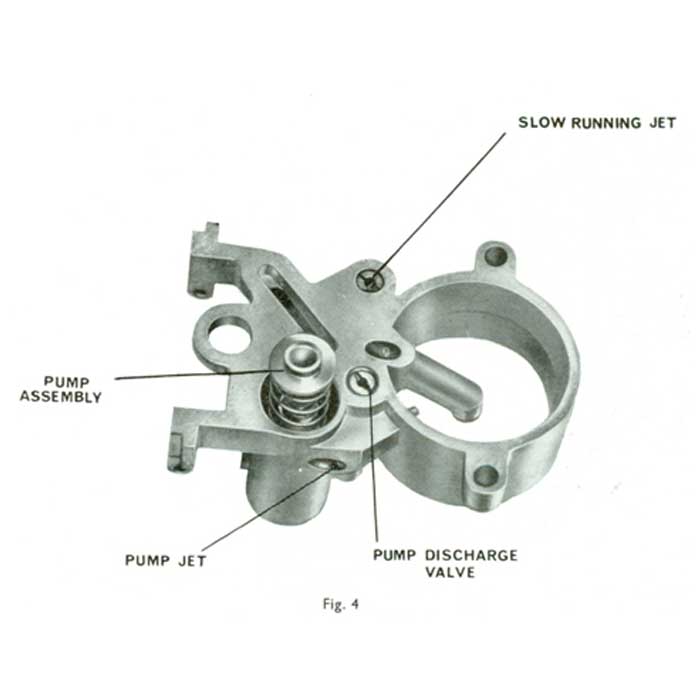
At full throttle or when manifold depression is low the air bleed through the ventilation screw is limited by the air having to pass through the small full throttle air bleed orifice 32, as the diaphragm 30 will be closed on its seating by the spring 31. Increasing the air bleeding by fitting a larger ventilation screw will weaken the mixture by reducing the depression on the main and compensating jets.
By variation to the ventilation screw, it is possible to alter the mixture ratio between low and high speeds at part and full throttles. Any alteration to the size of the screw will affect the mixture strength over the whole speed range, but will have a greater influence at high speeds, when the depression in the waist of the choke tube is at its maximum.
Pump jet
This jet governs the amount of petrol injected into the choke tube when the accelerating pump (which is interconnected with the throttle) is depressed. Apart from possible variations to the size of the pump jet, the stroke of the pump piston can be altered as already referred to in the descriptive notes.
In hot weather, or in a country where the average day temperature is appreciably higher than in the United Kingdom, it will usually be found possible to employ the short pump stroke without affecting acceleration adversely. On the other hand, during severe weather. or in a colder climate, it will be found an advantage to use the long stroke. Either adjustment may quickly be made when required.
Interconnection for cold starting
The degree of throttle opening when the strangler is closed is preset by the length and set of the rod 1. If the throttle opening is not to the specification for a particular application the only way to alter this is to set or bend the interconnection rod.
Petrol level
This is set at the Factory 15.5 mm. down from the top edge of the f1oatchamber. It should be explained that this level is that which should result when the top half carrying the float is in position on the carburetter,
and the float is holding the needle closed against the pressure of the petrol in the fuel line. When the top half is taken off and the float is lifted out of the chamber the level will fall.
To check the level remove the top half and leaving the float in position reverse the cover so that the float arm closes the needle, then measure from the face of the gasket to the highest point of the float, which should be 32-33 mm.
The level can be altered by bending carefully the tag on the float arm that contacts the end of the needle or an easier method is to vary the thickness of the washer under the needle seating, a thicker or an additional washer lowers the level. Needle valves and seating’s These are calibrated in millimetres, the size being stamped on one of the flats of the hexagon. This size depends on the fuel pump pressure and the capacity and power of the engine.
General
In addition to the foregoing jets, air bleeds, etc., which could, where necessary, be changed aft.er the carburetter is in service, there are many drillings in the instrument which can be varied during manufacture and are used in tuning the carburetter to an engine. It will therefore be understood the design is such as to enable the unit to be tailored to the requirements of the particular engine on which it is fitted. On the other hand, once the sizes of the different variables have been determined the mixture strength at various speeds and loads will remain constant, provided the jets and passages in the carburetter are clean and the mechanical condition of the instrument is sound.
In any investigation of suspected faulty carburation, first of all check through the instrument to ensure the specification, which includes choke tube, jet and air bleed sizes, is correct for the particular application.
Whilst it is important to ensure that jets have the right numbers stamped on them, the possibility should not be overlooked that a jet may have been tampered with, or careless cleaning has affected the flow of petrol or air through a jet or air bleed. If, therefore there is any indication that any of these have been interfered with, a new part of the correct size should be fitted.
Whilst a general check of the carburetter is advisable in the investigation of any complaint, we detail below, under specific headings, points that have a bearing on the particular trouble.
Difficult starting from cold
Make sure there is petrol in the f1oatchamber, and that petrol from the fuel pump flows through the needle seating within a few seconds of rotating the engine by the starter, or by operation of the hand primer on the fuel pump.
Cases are encountered where sediment or gum cause the needle to stick on its seating, thus preventing the entry of fresh petrol when attempting to start. This will explain difficult starting, as petrol in the float chamber when the engine is switched off may have evaporated after the car has been standing for several hours.
If a sticking needle is suspected, remove the top half and operate the needle with the finger. Any tendency for the needle to remain closed can usually be overcome by rinsing the needle and seating in mentholated spirit. This will dissolve sediment or gum deposit. Ensure that the strangler flap in the air intake closes completely when the choke control on the dash is operated. from examination of the choke control on the carburetter it will be seen there is no mechanical connection between the strangler control wire and the spindle on which the strangler flap is fitted.
Movement of a cam lever on the side of the air intake permits the spring loading of the strangler spindle and arm to close the flap in the air intake; therefore undue friction by reason of a bent strangler spindle, carboned-up bearings or a broken spring would explain non-closure of the flap when the choke control is out. Removal of the air-cleaner connection will enable this to be checked.
Excessive tightening of the air cleaner connection could distort the air intake out of round which could cause the strangler to stick open and cause difficulty in starting from cold. The intake is not fragile and the above would only occur if excessive force is used in tightening the cleaner connection.
The interconnection between the strangler lever and the throttle should ensure that the latter opens beyond the normal slow- running position, when the strangler is fully closed. The setting for a particular engine includes the amount the throttle should open when the strangler is shut. The measurement given is the gap between the edge of the throttle and the side wall of the throttle bore (on the slow-running outlet side), but it is also translated into half-turns of the throttle stop screw, from the point at which the screw commences to open the throttle from the dead-shut position.
Difficult starting when engine is hot
This trouble is caused by an over-rich mixture and can be a source of annoyance, particularly in hot climates but as the IV series carburetter is of anti-percolating design no trouble should be encountered, provided the carburetter is in good condition and the fuel pump pressure is not excessive. If this fault is experienced, first ensure that the needle and seating fitted is of the correct size. Having cleaned the assembly replace it with the correct washer, ensuring it is screwed tightly in position.
Examine the float to ensure it is not damaged or bent. See it moves freely on the axle-pin. A new needle and seating of the size specified will eliminate the possibility of the assembly being worn and no longer able to withstand normal fuel pump pressure. Where it is found that petrol floods into the manifold from the outlet of the emulsion block within second; of switching off the motor in spite of fitting a new needle and seating, check the fuel pump pressure, and if necessary have it reduced to prevent the internal flooding which could explain difficulty in hot starting. An additional washer under the needle seating may be effective in preventing flooding and could be tried before recourse to lowering pump pressure. Generally one can start the motor by gently opening the throttle to the fully or near-fully open position, then rotating the engine by the starter to clear the over-rich condition.
Erratic slow-running or stalling on deceleration
Make certain the slow-running jet is clean, also ensure that the feed hole to the channel in which the jet screws is free. The best method of checking this is to remove the slow-running and main jets, then insert the nozzle of a syringe filled with petrol into the hole from which the slow-running jet has been removed; on operating the syringe, petrol should flow from the hole from which the main jet has been extracted.
It is also necessary to ensure that the slow-running air bleed, into the air intake. is clear. Check to make certain that the slow-running outlet hole and the progression hole or holes in the throttle barrel are clear, and not
carboned up to restrict the orifice.
Remove the volume control screw to make sure the tapered end is in good condition. If it has been screwed down hard into the slow-running hole several times, a parallel portion will have been formed on the taper; this will render abortive any attempt to adjust the screw, which should be replaced with a new one. Make certain the spring under the head of the screw effectively spring-loads the screw, to prevent it vibrating out of position when set.
It is most important to check the floatness of float chamber, float chamber cover and emulsion block faces. Faces should be rubbed on a flat surface, covered with fine emry cloth, or on a lapping plate. Any leakage at these meeting surfaces will prevent consistent slow-running being achieved cause stalling on gradients and give poor pick-up.
The degree of throttle opening will determine the speed of slow-running, while the adjustment of the volume control screw will vary the mixture strength. Set the former to give a reasonable idling speed (usually in the order of 500/600 r.p.m.) then adjust the volume control screw so that at the speed as set by the throttle stop screw the engine will idle evenly, with no tendency to stall on snap closure of the throttle. Also make certain that, as the throttle is opened slowly from the idle position onto the progression holes, there is clean progressive acceleration of the speed of the engine.
Having set the volume control screw, it may be necessary to re-adjust the throttle stop screw slightly to give a satisfactory idle speed. In time, wear of throttle spindle and the bearings in which it operates will cause difficulty in obtaining satisfactory idling and explain hesitation and flat spots in opening-up off idle on to the main carburetter. Stalling of the engine is usually due to the idle speed being set too slow or the mixture too lean.
It is essential that the foregoing adjustments are made when the engine is at normal working temperature. While the motor is cool during the warming-up period, extension of the choke control will provide the wider throttle opening that will be necessary to prevent the motor stalling.
Excessive Fuel Consumption
Having checked to ensure the carburetter has the standard setting of jets and air bleeds fitted, make certain that all holes and passages in the instrument are clear. See that the strangler flap in the air intake opens completely when the dash control is released or pushed in.
Dismantle the economy device to make sure the diaphragm material is intact, and is in good condition, also that the gaskets (one each side of the diaphragm) are in position and are in good condition. If a replacement diaphragm is needed it is always best to fit new gaskets and a new spring as the tension of the spring is vital to the correct operation of the economy diaphragm.
When re-assembling the economy diaphragm, etc., see that the spring beneath the cover is in position and is located squarely in the recess of the metal cup in the centre of the diaphragm. Take care to tighten evenly and fully the screws which secure the cover. Any leakage at the joint will affect the degree of depression necessary to overcome the spring tension which normally holds the diaphragm down in the closed position.
Remove the ball valve that screws into the top face of the emulsion block to make certain the ball moves up and down quite freely, and will drop by its own weight. Sediment or gum could explain the ball sticking on the upper seating; in this event petrol will issue from the pump jet at all times and affect consumption adversely. Usually any tendency for the ball to stick can be overcome by washing the assembly in mentholated spirit.
It will be appreciated that when the ball drops, any depression over the pump jet will merely admit a limited volume of air from the uncovered air bleed at the top of the valve. If there are symptoms of richness on idling and adjustment of the volume control screw fails to rectify the richness this would point to internal flooding, the needle not closing on its seating by reason of dirt, worn needle and seating or to excessive pressure from the fuel pump.
Clean the needle and seating, ensure the seating is fitted with the soft aluminium washer and is screwed tightly in position. Make certain the gasket under the emulsion block is in good condition. Ensure the float moves freely on the axle pin. A new needle and seating, of the size specified for the particular application, with a new washer should be fitted if the needle shows signs of appreciable wear. Should it be found that after the above attention the obvious richness persists the explanation is doubtless excessive fuel pump pressure and this should be checked and lowered. It will be seen there are no joints below the petrol level in the float chamber from which leakage can occur.
Poor Acceleration
Check that the pump piston moves freely in its cylinder, and returns to the upper position by the spring incorporated in the assembly. Having removed the piston ensure the cylinder is clean, syringe petrol through the ball valve in the base of the cylinder to make certain the non-return valve will close effectively on the downward movement of the pump piston. Remove the pump jet to ensure it is perfectly clear to give an unbroken stream of petrol from the orifice when the pump piston is pushed down.
If the pump link is in the short position, try the linkage in the hole which gives the maximum length of piston travel. Dismantle the economy device to ensure the diaphragm material is sound, as it will be appreciated that on snap acceleration, the release of the depression on the engine side of the throttle, which previously will have held back the diaphragm against the compression of the spring will result in the valve closing the main air ventilation to the jets. This temporary closure of the diaphragm valve will result in faster emptying of the reserve of petrol in the passages in the emulsion block above the main and compensating jets, which supplements the petrol from the pump jet.
Larger pump jets are available to meet special conditions.
In time, wear of the carburetter will result in reduced output from the pump and affect acceleration and slow-running adversely. Flat spots or hesitation on progressive opening can generally be eliminated by careful adjustment of the slow-running mixture, after making certain the progression holes in the throttle barrel are clear.
Loss of Power
Make certain that all jets and passages in the emulsion block are clear, and that the throttle is opening fully. Larger main and compensating jets may be tried to see if increasing the strength of the mixture will improve maximum speed and power. In cases where an engine has been modified with a view to ,increasing power output and we are advised of modifications made, we can usually suggest an alternative setting which will serve as a basis for commencing tests to tune the carburetter to suit the altered or modified engine. These remarks apply equally to conversions to twin or multiple carburetters, and we shall be pleased to pass on to owners the benefit of our experience on similar installations.
Twin Carburetters
On certain applications, twin carburetters are fitted. It is important that petrol levels and settings in both carburetters are the same. Care must be taken to ensure that the throttles are correctly synchronised. It is essential to adjust the throttle opening in both carburetters the same amount, from the dead shut position, to give the desired idle speed. This will ensure that as the accelerator pedal is depressed to move away, the progression holes in both carburetters come under depression at the same time, to give clean opening-up with no hesitation or flat spot.
If idling speed or mixture varies and needs frequent attention, the probable explanation is leakage at manifold joints, and these should be checked to make certain all are air-tight. In dismantling the carburetter for cleaning and checking jets, etc., it is advisable to have available a set of new gaskets. There is a Gasket Pack containing all washers and gaskets, in kit form, to suit the particular model on your car. Insist on the genuine Zenith Pack-nothing else is as good.
